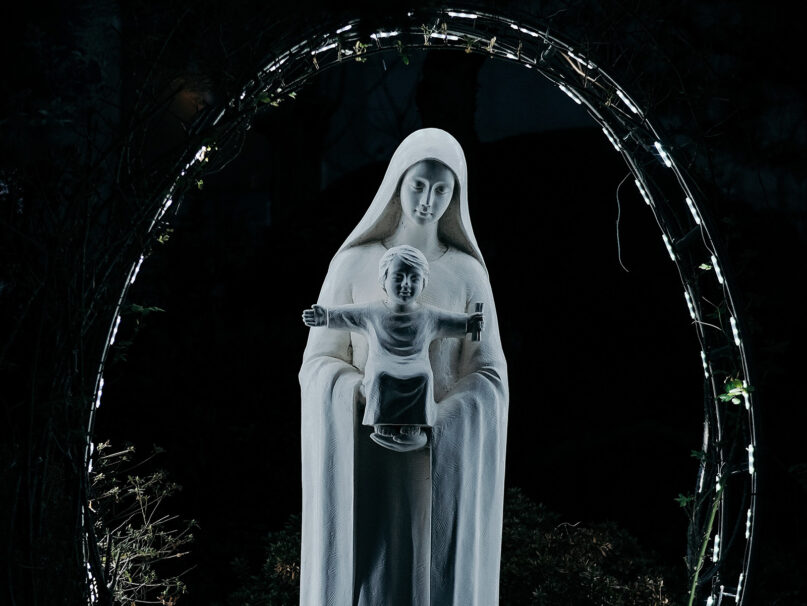(RNS) — Muslim-Christian relations are strained around the world, across the United States and even in Congress. But at Christmas, the two faith communities whose combined size represents more than half of humanity can look to their shared love for a single figure to inspire them to love one another: Mary, the mother of Jesus.
Mary is more than the only woman named in the Quran; she has an entire chapter bearing her name. She is mentioned more times in Muslim scripture, in fact, than in the New Testament. She is lauded by God in the Quran as “chosen among all women of the world,” “a sign for humanity,” and as “a model” of piety, purity and patience.
Through the centuries, from ancient artwork of the Middle East, South Asia and Far East to the contemporary Iranian film “Saint Mary,” Muslims have lovingly captured the mother of Jesus. We reflect on how we may be inspired by her — as a devotee of the Lord, as a woman, as a single mother and as a role model for all Muslims, men and women alike.
Christians and Muslims have and continue to revere Mother Mary, standing shoulder to shoulder as pilgrims and worshippers, at sites around the world from Syria and Lebanon to Israel and the Philippines.
RELATED: Mary, mother of Jesus, returns as an icon for pop stars and social justice warriors
Over the past few months, I’ve heard how the Blessed Mother has inspired spiritual awakening among Catholic professionals, delivered peace to struggling single Muslim mothers, inspired dialogue among Jewish and Christian empty-nesters, offered solace to agnostics looking for meaning and helped a Muslim convert to Christianity explain to her worried priest that loving both Islam and Christianity is what Jesus would do.
Hearing about Muslims’ love for Mary, Islamophobes and Islamophiles find that they are bound by reverence for the mother of Jesus and grateful to her for bringing them closer together.
Mother Mary’s healing power is the beacon of hope and light we need right now.
Anti-Muslim sentiments are held at an alarming rate by Christians. Two decades after 9/11, 75% of white evangelical Protestants and 58% of white U.S. Catholics believe that Islamic values are at odds with American values, according to the Public Religion Research Institute.
Half of Americans believe, furthermore, that violence, rather than peace, is encouraged by Islam, a faith practiced by 1 in 4 people in the world. (In the months after 9/11, only a quarter of Americans believed this myth.)
Yet for two decades Muslims in America have been the victims of hate and violence, not its perpetrators. Since 2010, FBI hate crimes data shows, Muslims have been the second most common target of religious hate in America (after Jews).
In recent weeks and months, Islamophobic rhetoric has translated into bias or violence against Muslims across the nation, as well as the emergence of allies and calls for redress (for example, in Florida, New Jersey, Illinois, California, New Mexico, Washington). Children are not spared. The 2020 American Muslim Poll reveals that 55% of students in K-12 public schools face religious bullying — 30% of the time by teachers or school officials.
Muslims on campus don’t fare much better. A recent report examining Islamophobia at California universities and colleges found that nearly 40% of Muslim students report racial discrimination or harassment, including by professors (34%), peers (54%) and student services (23%). More than 1 in 5 Muslim university students have been denied accommodations.
Refuge can’t be found at work, either. The Equal Employment Opportunity Commission reports that Muslims have constituted 20%-28% of workplace religious discrimination claims every year between 2002-2017 though they are only 1% of the American population.
Research shows a promising path out of this situation. A national longitudinal study of Gen Z college students across the U.S. found that young people developed mutual understanding by breaking bread together, touring one another’s houses of worship, attending vigils and other informal encounters together and volunteering side by side for common causes such as eradicating homelessness and poverty.
Mary, mother of Jesus the Messiah, who is upheld in the Bible and the Quran as a righteous, humble servant of God to be emulated, can be our guide in finding shared values such as compassion, generosity and care for the poor and the weak.
RELATED: What to give your Jewish neighbors for Christmas
Two millennia after she gave birth to Jesus, Mother Mary has the power to unite Muslims and Christians wary of one another. Lady Maryam (as she is called in the Quran) is a symbol that can help us replace hardened hearts and burdened souls with peace, love and understanding.
Nothing about interfaith harmony detracts from our commitment to our respective beliefs. In reaching out across lines of difference, we take a page from the World Evangelical Alliance, the Vatican, the Ismaili Imamat, the Muslim World League and the World Jewish Congress, each of which has supported interfaith dialogue to foster peace and respect around the world.
At Christmas, and all year long, let each of us find fellowship in listening deeply and connecting spiritually. Let every one of us replace fear with hope and recognize that “the Other” is not a bogeyman to fear, but a blessing to learn from and to cherish. Let Mother Mary lead us in that process.
(Zahra N. Jamal is associate director of the Boniuk Institute for Religious Tolerance at Rice University and CEO and founder of The Inclusion Expert, a culture and diversity consultancy. The views expressed in this commentary do not necessarily reflect those of Religion News Service.)





